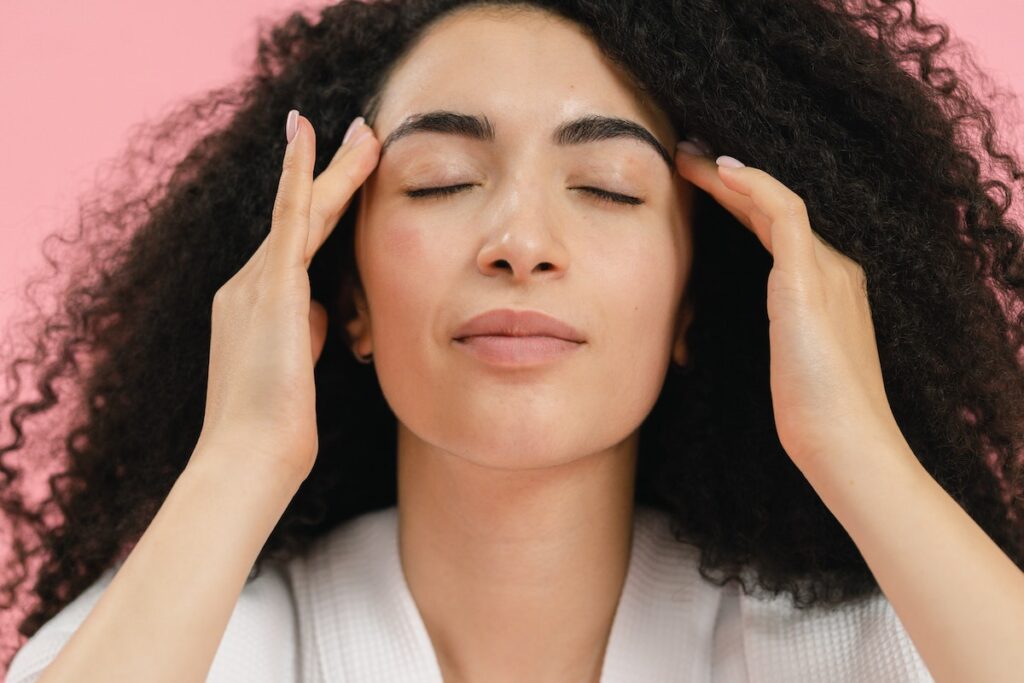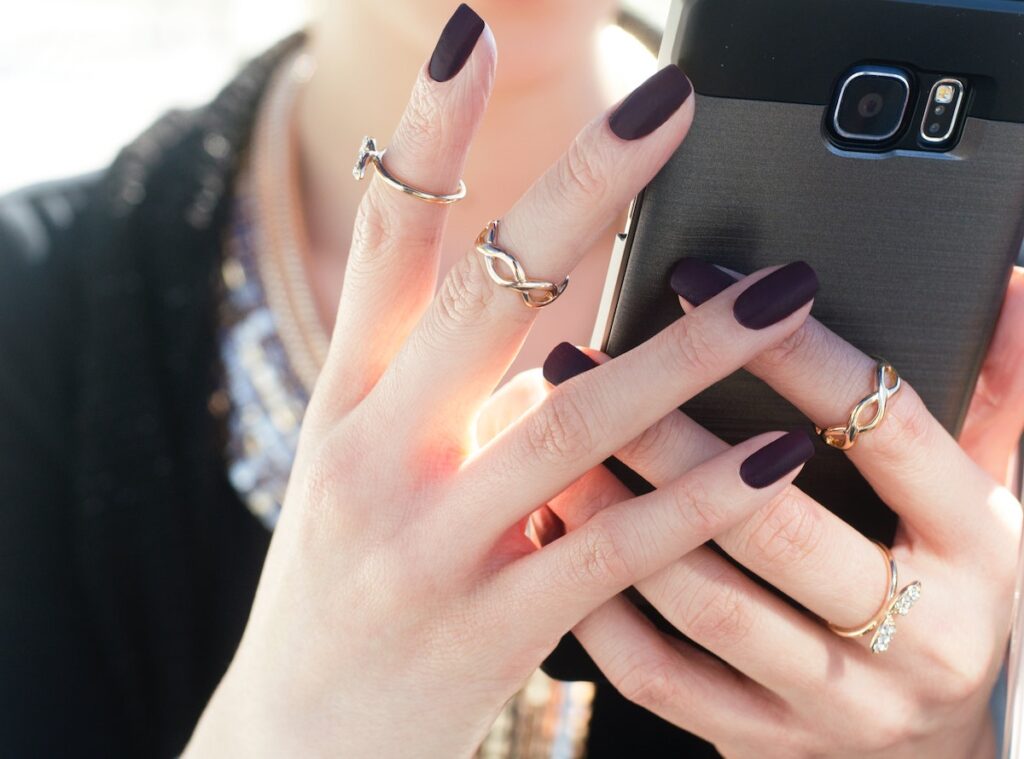Glow Up Guide: 6 Ways To Care For Your Hair, Skin & Nails Naturally

Did you know? One of the unexpected signs and symptoms of peri and post-menopause can be changes to hair, skin and nails. Not quite what we ordered, is it?!

Indeed, entering perimenopause, menopause, post-menopause and midlife is a transformative phase in a woman’s life. And not all of it’s welcome (eye roll).
And along with that huge change (‘the change’ isn’t a popular term but it fits) comes numerous emotional and physical changes. In fact, there are 34 recognised symptoms of menopause and counting.
The secret is understanding and adapting to these changes to help you maintain a vibrant and radiant appearance. And if you give a toss what you look like, isn’t that one of the learnings of midlife?
Don’t miss: Ditching Dye? Meet The ‘We Love Our Grey Hair’ Brigade
Let’s talk hair, skin and nails

As your reproductive hormones (mainly estrogen and progesterone) lower it can impact skin, hair and nails.
Estrogen’s a major player here as it has an active role in the health of our hair, skin and nails. Skin can become drier, nails more brittle and hair loss and thinning can raise (pardon the pun!) their heads. And this can be confronting for many of us.
Understanding hormones and hair health
Sorry(!), but it’s important to note that around 40% of women will experience some form of hair loss or thinning by age 50. In fact, more recent research in the Menopause Journal showed this was more like 52%.
Many women will experience some form of hair thinning/loss by age 50
It often shows up as a widening at the part line or receding hairline at the temples.
Hair loss during perimenopause and menopause can be due to an imbalance of estrogen and androgen (testosterone and DHEA). When things are going well these androgens are converted into dihydrotestosterone1 (DHT) which supports blood flow to the hair follicle.
However, if the system’s not behaving hair follicles can shrink and your hair’s natural growth process can be disrupted.
Every hair follicle cycle lasts around two to five years and it’s quite normal to shed around 50-100 strands of hair per day.
Stress
 But during peri / menopause hormonal shifts and life stresses such as grief, relationship issues, illness, thyroid dysfunction and poor nutrition can interrupt the flow. So, as a lot of these occurrences can raise their head at midlife, and by default menopause, it can become more prevalent at this life stage.
But during peri / menopause hormonal shifts and life stresses such as grief, relationship issues, illness, thyroid dysfunction and poor nutrition can interrupt the flow. So, as a lot of these occurrences can raise their head at midlife, and by default menopause, it can become more prevalent at this life stage.
And heck, if things are way too much to handle the hair follicle may even turn off and become inactive for a time.
Most of us will experience the hair loss stress response – technically known as telogen effluvium – at some point in our lives but it’s usually temporary. Furthermore, hair thinning/loss driven by hormone change can be lessened although genetic hair loss can be more permanent.
6 tips for managing hair thinning, dryness, and brittleness
1. It’s all in the brush
One way to figure out how you’re faring is to check your hairbrush. While it’s normal to collect hair strands in the bristles if the amount accumulating has increased it’s a pretty fair sign you’re losing hair.
2. Protein, Fat, Fibre
Ensure your diet is nutrient rich and contains plenty of iron as well as vitamin D. Choose whole foods, protein, fat and fibre and avoid processed and refined.
3. Take a break
It can be a smart idea to take a break from daily styling and the use of heated appliances which can damage the protective outer hair layer.
4. Choose hydration
Use hydrating shampoos and conditioners – a rich hair mask once a week is an extremely good habit to get into.
5. Simply the best
Go for high-quality products, the cheaper ones can tend to be detergent-based and drying.
6. A weekly mask (read that again)
If you’ve embraced your grey hair, it tends to be dryer and frizzier so the weekly hair mask can be a game changer for you.
Tip: LotsaLocks® supports hair density at the follicles
How do fluctuating hormones affect your skin?

As we noted earlier, dropping estrogen in menopause can impact hair, skin and nails and lead to dryer, thinner skin.
What’s more, the skin is our largest organ so it’s not just the face that’s affected but the entire body.
You see, estrogen plays a regulatory role in the thickness of your skin, its moisture content and blood flow.
We often say estrogen is your ‘juice’ and as it decreases so do our skin’s natural hydrators such as lipids (the oil barrier) and hyaluronic acid (HA).
In addition, what’s known as transepidermal water loss (TEWL) can increase as well as the natural evaporation of water from the skin.
Further, one of estrogen’s roles is to contribute to the production of collagen and elastin, the protein fibres behind a plump and elastic complexion.
Tip: LotsaLocks® triggers the production of collagen IV and VII
Related: How To Have Great Skin After 40

6 tips to up your skin’s hydration, flexibility and radiance
1. Oil up (it’s not what you think!)
I take a spoonful of extra virgin olive oil a day but if you can’t stomach it use 20-30ml over food and take omega-3 or evening primrose oil supplements. While these are great for the skin, they’re also hormone helpers. Win, win!
2. Moisturise
Choose skin moisturisers with gold-standard hydrators such as hyaluronic acid and/or glycerine. They should be high up on the ingredients list. You want a humectant or occlusive. Humectants contain ingredients that draw water from the air while occlusives create a barrier on the skin to help reduce moisture loss.
3. Choose to rejuve
One of the best ingredients for adult skin is a good quality vitamin A aka retinol or retinoid. Used in the right percentages, vitamin A is proven to strengthen skin and stimulate collagen and cell turnover. However, you need the right amount and formulation otherwise they don’t work so seek expert advice when choosing a vitamin A.
Note: The best skincare to use at this time should be as natural as possible to avoid xenoestrogens and endocrine disruptors.
Listen: Exploring The Impact Of Xenoestrogens & EDCs
4. Love your bod
The decline of estrogen shows on your body skin too. So dry body brushing and oiling can be super helpful. Use a long-handled natural bristle body brush or exfoliating gloves and, starting at your feet brush upwards. Follow with fractionated coconut, sesame (not the cooking kind) or olive oil and step into the shower to rinse off. Pat dry.
5. Eat the rainbow, oodles of bitter greens & nix the sugar
Nutrients aren’t just the cornerstone of great health but also one of the building blocks of great skin. Eat the rainbow to get all the power of antioxidants for skin strength. Further, ingesting bitter greens like rocket, kale and watercress helps to detox your liver, which will manifest on your skin.
And when it comes to refined added sugars, they create inflammation which breaks down collagen and elastin resulting in sagging and wrinkles.
Read our sugar series here:
- Sugar, Hormones & Weight Gain
- 10 Ways Your Life Will Improve Without Sugar
- 10 Changes Sugar Can Cause In Your Body.
6. Embrace the facial
Ha! Yes, we are suggesting you get a facial – bet you love this tip best (smiling face).
But seriously, a facial is not only wonderful skin therapy it’s wonderful you-time too. A non-negotiable during peri / menopause if you can swing it. Physiologically, facial massage helps increase blood flow to your complexion and the production of collagen.
And it should go without saying…
…always choose gentle skincare formulations, keep up your hydration by drinking H2O and avoid long, hot baths and showers. The latter is super dehydrating and can strip the skin of its precious natural oils.
Always bear in mind that you want to nurture your skin barrier.
How hormonal changes influence nail strength and growth
Just like your hair and skin, your nails can become thinner, dryer and more brittle when estrogen plummets.

The keratin layer on nails makes them strong and hard but dropping estrogen causes this layer to weaken. In addition, the body’s loss of water volume can contribute to nail plate changes.
Therefore dropping estrogen levels can contribute to brittle, soft, peeling, splitting and slower-growing nails.
6 tips for nurturing brittle, weak nails
1. Be hand aware
When you think about it our hands do a lot of hard graft so rather than soaking them in detergents use gloves as you go about your chores.
2. Watch your diet
Choose whole, unprocessed foods and focus on lean protein, good fats and ensure you’re getting your omega-3 essential fatty acids.
3. Drink more water
One of estrogen’s functions is to regulate water levels in the body (see skin). So keeping a water jug handy and choosing high water content foods like cucumber and lettuce is smart as dehydration contributes to brittle nails.
4. Do an olive oil soak
One tried and true trick is soaking nails in warm olive oil for 10 minutes because it conditions and strengthens them.
5. Hand cream
Use hand cream as often as possible and because we use our hands for so many things repeated, regular applications are best. Hand creams can provide hydration as well as create a protective barrier.
6. Go to the nail spa
Oooh yes, it’s another blissful goody! The hand massage that’s part and parcel of a good manicure or getting your nails done can also stimulate blood flow and the production of collagen (see facial).
Tip: Nails grow faster and stronger visible with LotsaLocks®
Related: 9 Ways To Deal With Soft & Brittle Nails
Is it time to see a pro for hair, skin and nail issues?
It makes good sense to see a professional such as a trichologist or dermatologist to ensure you don’t have an autoimmune condition or other health reasons that may be causing your concerns.
Sometimes things such as a lack of iron or folate may be contributing. And thyroid issues could also be behind some of what you’re experiencing.
Ensure you ask for a full panel thyroid test not just TSH as TSH levels may read OK even if your thyroid isn’t functioning optimally. Free T3, free T4, reverse T3 and thyroid antibodies give a fuller picture.
Conclusion:

Perimenopause, menopause and post-menopause can bring forth a whole host of changes to skin, hair and nails.
However, by putting in place some hair, skin, and nail care strategies you can navigate these stages with confidence.
What do you think? Have you got a goof-proof tip you use for your hair and nails?










